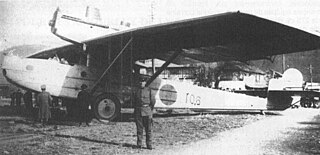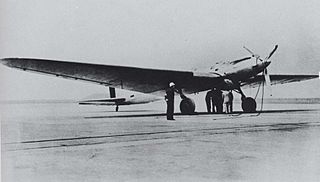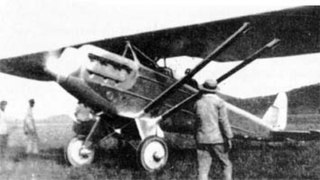
The Dornier N was a bomber aircraft designed in Germany in the 1920s for production in Japan. Production of 28 aircraft started in Japan in 1927, as the Kawasaki Ka 87. Designed and built as a landplane, its layout was strongly reminiscent of the Dornier flying boats of the same period; a parasol-wing, strut-braced monoplane with two engines, mounted in a push-pull nacelle above the wing. Some of the 28 examples built saw action in Manchuria in 1931.

The Kawasaki Army Type 88 Reconnaissance Aircraft was a Japanese single-engined biplane designed for Kawasaki by Richard Vogt. Originally known by its company designation KDA-2, it was accepted by the Imperial Japanese Army as the Type 88 Reconnaissance Aircraft. The Type 88 number was designated for the year the aircraft was accepted, which was the year 2588 in the Japanese imperial year calendar, or 1928 in the Gregorian calendar. The basic design was modified into the Type 88 Light Bomber that was used in combat over China in the Second Sino-Japanese War. The Type 88 was built in large numbers and remained in service until 1940.

The Kawasaki KDA-5 was a Japanese single-seat biplane fighter designed by the German Dr. Richard Vogt for the Imperial Japanese Army.
The Kawasaki KDC-2 was a 1920s Japanese light civil transport which Kawasaki developed from its Kawasaki Army Type 88 Reconnaissance Aircraft. Two were built and flown in 1928 and flew both regular and irregular services; the last retired in 1935.

The Mitsubishi Ki-2 was a light bomber built by Mitsubishi for the Imperial Japanese Army Air Service (IJAAS) in the 1930s. Its Allied nickname was "Louise". Despite its antiquated appearance, the Ki-2 was successfully used in Manchukuo and in North China during the early stages of the Second Sino-Japanese War, in areas where danger from enemy fighter aircraft was minimal. It was later used in a training role.

The Kawasaki Ki-3 was a light bomber built by Kawasaki Kōkūki Kōgyō K.K. for the Imperial Japanese Army in the 1930s. It was the last biplane bomber design to be produced for the Imperial Japanese Army Air Force, and saw combat service in Manchukuo and in north China during the early stages of the Second Sino-Japanese War.
The Kawasaki Ki-5 was an experimental low-wing monoplane fighter aircraft designed for the Imperial Japanese Army Air Force. It first flew in February 1934, but was never produced for actual use. It was the last Japanese design led by Richard Vogt before he returned to Germany.

The Nakajima Ki-11 was an unsuccessful attempt by Nakajima Aircraft Company to meet a 1935 requirement issued by the Japanese government for a modern single-seat monoplane fighter suitable to meet the needs of both the Imperial Japanese Army Air Force and Imperial Japanese Navy Air Service
The Nakajima Ki-19 was an unsuccessful attempt by Nakajima Aircraft Company to meet a 1935 requirement issued by the Japanese government for a modern bomber to replace the Mitsubishi Ki-1 heavy bomber.
The Aichi AB-1 was a result of a 1926 government call for a small, Japanese-built, civil transport biplane able to operate from land or water. It won the contest in both roles but did not reach production as airlines moved from biplanes to monoplanes. Nonetheless, it remained in commercial use well into the 1930s.
The Hitachi TR.1 was a small airliner developed in Japan in 1938, produced in small numbers as the TR.2. It was a low-wing, cantilever monoplane with retractable tailwheel undercarriage and a fully enclosed cabin. The design strongly resembled the Airspeed Envoy that it was intended to replace in Japanese airline service. Testing of the TR.1 prototype commenced on 8 April 1938 at Haneda Airport, but it suffered a serious accident on 22 June due to a landing in which one of the main undercarriage units failed to extend.

The Mitsubishi Army Type 92 Reconnaissance Aircraft (九二式偵察機) was a Japanese short-range reconnaissance aircraft of the 1930s designed by Mitsubishi for the Imperial Japanese Army Air Force. A total of 230 were built, serving between 1933 and 1936. A parasol monoplane, the Type 92 was the first military aircraft powered by an engine both designed and manufactured in Japan to enter service.

The Manshū MT-1 Hayabusa was an airliner produced by the Japanese Manchuria Airplane Manufacturing Company in Manchukuo in the late 1930s. It was a conventional, low-wing cantilever monoplane with fixed tailwheel undercarriage. The flight deck was fully enclosed and separate from the passenger cabin, which could seat six people. The type equipped Manchukuo National Airways.

The Gasuden Koken was a Japanese long-range research aircraft of the 1930s. It was built by the Tokyo Gas and Electric Industry, to break the world record for longest flight, setting a closed circuit world record of 11,651.011 km (7,240 mi) in March 1938.
The Kawanishi K-12 Sakura was a Japanese experimental long-range aircraft of the 1920s, intended to be the first aircraft to fly non-stop across the Pacific Ocean. Two examples of the K-12, a single-engined high-winged monoplane were built. As testing showed that its performance was inadequate, it was abandoned, no attempt being made on the trans-Pacific flight.

The Mitsubishi MC-1 was a 1920s Japanese single-engined biplane airliner designed and built by the Mitsubishi Aircraft Company.

The Kawasaki KDA-3 was a single-engine, parasol wing, single seat experimental fighter aircraft designed by Dornier engineer Dr. Richard Vogt and built by Kawasaki for the Japanese Imperial Army, first flying in 1928. The KDA-3 was built to replace the Ko-4 but only three prototypes were built and it was not ordered into production.

The Kawasaki KAL-2 is a Japanese four/five seat, single engine aircraft, designed for both military and civil markets in the mid-1950s. Only two were completed.
The sole Kawanishi K-2 was the first specialized Japanese racing aircraft. The advanced, single-seat low-wing monoplane's first flight was in the late summer of 1921. It had a promisingly high maximum speed but a career limited by numerous minor accidents produced no victories or records.
The Itoh Tsurubane No.1 was a single seat aviation demonstrator and trainer biplane first flown in Japan in 1918.












